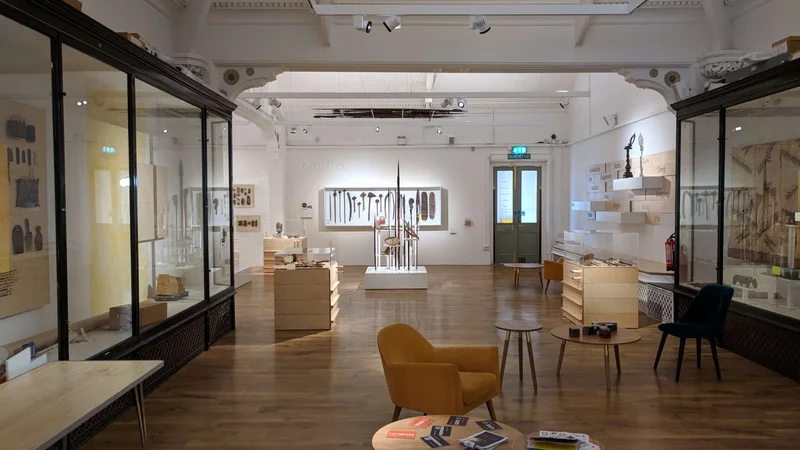Trauma-informed practice in museums cannot be sustained through one-time workshops or isolated projects. Ideally, it should become part of the museum's everyday culture—woven through exhibitions, staff interactions, policies, and partnerships. The aspiration is to move beyond discrete sessions and toward an environment where trauma-informed practice is lived daily.
In practice, sustaining this approach is difficult. Staff turnover can lead to the loss of institutional knowledge. Deadlines and funding requirements often push trauma-informed practices aside. The aspiration is not perfection but steady reinforcement: embedding trauma-informed principles into onboarding, meetings, and evaluations so they remain visible and actionable.
Embedding in Onboarding and Orientation
One effective way to sustain trauma-informed practice is to introduce it at the beginning of employment. Ideally, every new staff member—whether in visitor services, curation, collections, or administration—receives orientation in trauma-informed principles and strategies. This creates a shared foundation and signals that these practices are not optional but central to how the museum operates.
In practice, onboarding is often rushed due to competing demands for attention. Trauma-informed content may be postponed or abbreviated. The aspiration is to treat it as essential rather than supplementary. Even a brief orientation—an hour or two—can introduce core concepts: what trauma is, how it affects people, why self-awareness matters, how to notice activation in oneself and others, and when to ask for help. More detailed training can follow once the person has settled into their role.
Onboarding should also acknowledge that working in museums often involves exposure to difficult content. New staff need to know that strong reactions are normal, that support is available, and that taking breaks is encouraged. They need to know whom to contact if they feel overwhelmed. They need to know that trauma-informed practice is not about never struggling but about having resources and community to turn to when struggles arise.
Toolkits and Documentation
Written resources can sustain practices when memory or staff availability is limited. Ideally, museums develop concise toolkits with checklists, sample language, and reminders tailored for different roles. A toolkit for visitor services staff might include: how to recognize signs of visitor distress, prompts for offering support (It seems like this has been intense...), when to call for backup, and where to direct visitors for further resources. A toolkit for curators might include: questions to ask when designing exhibitions (How might this content activate trauma? What regulation spaces can we provide?), guidelines for content advisories, and suggestions for community consultation.
In practice, documentation may sit unused if it is inaccessible, overly complex, or disconnected from daily workflows. The aspiration is to integrate resources into existing systems. Checklists could be added to exhibition planning templates. Sample language could be included in staff communication guidelines. Reminders could be posted in break rooms or included in team meeting agendas.
Documentation should be living rather than static. As staff gain experience with trauma-informed practices, they will discover what works and what doesn't. The toolkits should be revised regularly to incorporate this learning. Staff should be invited to contribute: What would have been helpful to know when you started? What language works well for you? What strategies have you found effective?
Leadership Modeling
Leaders play a central role in sustaining culture. Ideally, supervisors model trauma-informed behaviours: taking breaks, acknowledging emotional challenges and vulnerability, welcoming feedback, and admitting limits. When a director says That exhibition planning meeting was harder than I expected. I need to step outside for a few minutes, they give permission for others to do the same. When a manager checks in with their team after a difficult project—How are you all doing? That was intense work—they signal that care matters as much as productivity.
In practice, leaders may feel constrained by external pressures and the expectation to project strength, competence, invulnerability. Organizational culture has long equated leadership with not showing struggle. The aspiration is to redefine authority as authenticity: the capacity to show up fully human, with limits and needs, while still holding responsibility. This shift is difficult because it asks leaders to be vulnerable in ways that feel risky. But it is also powerful, because it creates permission for everyone else to be human too.
Leaders also sustain trauma-informed practice by prioritizing it in resource allocation. If training is valued, a budget is allocated for it. If peer support is essential, time is protected for it. If toolkits need development, staff hours are devoted to creating them. Without resources, even the best intentions remain aspirational. Leaders who back their words with budgets and policies demonstrate genuine commitment.
Policy and Systems Alignment
Policies shape culture in ways that are often invisible until someone bumps against them. Ideally, HR policies allow flexibility for staff who need mental health support. Evaluation metrics reward collaboration and care, not only productivity. Exhibition planning includes trauma-informed checkpoints at every stage. Visitor services protocols include clear guidelines for responding to distress.
In practice, policies often lag. They were written before trauma-informed principles were adopted, and revising them requires navigating bureaucracy, legal review, and (sometimes) union negotiations. The aspiration is to review policies through a trauma-informed lens and adjust where feasible, even in small ways. Can sick leave be used for mental health days without requiring extensive documentation? Can staff rotate off high-exposure roles periodically? Can performance reviews include assessment of how well someone supports colleagues, not only their individual outputs?
Systems alignment also means ensuring that trauma-informed practices are integrated across departments. If the Exhibitions team embraces these practices but HR does not, staff will experience the disconnect. If leadership supports trauma-informed work but facilities doesn't maintain the quiet spaces needed for regulation, good intentions falter. True sustainability requires alignment across the entire organization.
Continuous Learning
Trauma-informed practice evolves. Research advances, cultural understanding deepens, new strategies emerge. Ideally, museums offer continuous learning—refresher workshops, peer exchanges with other museums, guest lectures from community partners or trauma specialists. These opportunities keep the work alive, prevent stagnation, and introduce new perspectives.
In practice, time and budgets may limit formal learning opportunities. The aspiration is to embed learning into the rhythm of work, even in modest formats. Team meetings could include brief case discussions: A visitor became very distressed last week. Let's talk about what happened and what we might do differently next time. Monthly emails could highlight a single trauma-informed principle with practical examples. Staff could be encouraged to attend external conferences or training and then share key learnings with colleagues.
Continuous learning also means learning from mistakes. Things will go wrong. A visitor will be retraumatized despite best efforts. A community partner will feel unheard. A staff member will burn out. A trauma-informed culture is not one in which mistakes never happen, but one in which mistakes are acknowledged, examined, and learned from. Leaders who say We got this wrong. Here's what we're going to do differently model the honesty and accountability that sustain trust.
Measuring Progress
Ideally, museums gather feedback from staff, visitors, and community partners to measure progress in trauma-informed practice. Surveys, focus groups, and conversations can show whether people feel safe and supported. Do staff feel they can speak honestly about emotional challenges? Do visitors know where to find support when needed? Do community partners feel their contributions are valued?
In practice, evaluation may be inconsistent or incomplete. Staff may fear consequences for honest feedback: If I say I'm struggling, will I be seen as weak? Will it affect my career? The aspiration is to use multiple methods—anonymous surveys, facilitated discussions, one-on-one conversations with trusted people—and to focus on learning rather than compliance. The goal is not to prove that the museum is doing trauma-informed work perfectly, but to understand where the work is strong and where it needs strengthening.
Metrics might include: percentage of staff who report knowing how to access mental health support; number of visitor distress incidents and how they were resolved; frequency of community consultation in exhibition development; staff retention rates in high-exposure roles; feedback from community partners about satisfaction with collaboration processes. These numbers do not tell the whole story, but they provide information for ongoing improvement.
A Culture of Care
Ultimately, sustaining trauma-informed practice is about cultivating a culture of care. Ideally, staff feel their well-being matters as much as visitor experience. Visitors feel their reactions are valid and supported. Community partners feel their contributions are honored. This culture is not built through mandates or policies alone but through countless small moments, repeated over time, until care becomes "how things are done here."
What does this look like day to day? It looks like a Collections staff member noticing a colleague seems withdrawn and saying Just checking in... It looks like a curator building regulation spaces into an exhibition plan from the beginning, not as an afterthought. It looks like a director ending a meeting by saying That was a lot. Let's take a few minutes before moving on. It looks like a visitor services staff member recognizing a family is overwhelmed and offering There's a quiet space just around the corner if you'd like a break. None of these moments is dramatic, but together they weave a fabric of care.
A culture of care also means acknowledging that care cannot be entirely individualized. It is not enough to tell staff Practice self-care when structural conditions make care impossible. If staff are overworked, underpaid, exposed to traumatic content without adequate breaks or support, no amount of individual resilience will prevent harm. Trauma-informed practice must address both individual capacities and organizational conditions. It must ask not only How can we help staff cope? but also How can we change conditions so there is less to cope with?
Looking Forward
Sustaining trauma-informed practice is long-term work requiring humility and persistence. There will be moments when museums fall short, when well-intentioned efforts cause harm, when constraints prevent best practices. The aspiration is to learn from these moments and keep moving forward, to recognize that trauma-informed practice is not a destination but a direction of travel.
By embedding principles into onboarding, creating practical toolkits, ensuring leaders model authenticity, aligning policies and systems, offering continuous learning, gathering feedback, and cultivating a culture of care at every level, museums can strengthen their role as both sites of truth-telling and places of healing. Trauma-informed practice is not something museums simply do—it is something they continually become, through the daily choices and commitments of everyone who works within their walls and everyone who walks through their doors.
The work is never finished. But the work is worthy. And in that ongoing commitment—to care, to honesty, to growth, to repair—museums embody the values they seek to illuminate for the world.
We are asleep with compasses in our hands.
Guide Navigation
The introductory page of the guide provides the context and rationale for trauma-informed museum practices and includes an overview of each page.
Understanding Trauma in Museum Contexts explores how trauma operates as a complex, ecological phenomenon affecting visitors, staff, and community partners. It examines the neuroscience of trauma responses, the patterns that emerge from person-environment interactions, and why museums need this foundational knowledge.
Considerations for Trauma-Informed Training addresses the personal dimension of this work—why trauma-informed training must be fundamentally different from typical professional development, how to build skills safely, and the importance of self-awareness and empathy as foundations for supporting others.
Core Principles of Trauma-Informed Practice outlines five interconnected principles—safety, trust, belonging, empowerment, and empathy—that guide all trauma-informed work. These are not implemented once but practiced continually, shaping how exhibitions are designed, how staff interact, and how partnerships are formed.
Supporting Colleagues examines what it means to care for one another in workplaces where exposure to traumatic content is routine. It explores the skills of presence, the importance of boundaries, and how to create a culture where supporting each other becomes ordinary rather than exceptional.
Trauma-Informed Exhibition Planning addresses the challenge of creating exhibitions that convey difficult truths with honesty while respecting visitor wellbeing. It offers practical strategies for content advisories, visitor choice, regulation spaces, and creative engagement that honors both truth-telling and care.
Working with Community Partners explores how to build genuine, reciprocal partnerships with communities whose traumatic histories museums represent. It emphasizes the importance of multiple sessions over time, incorporating creative work alongside discussion, and creating conditions where trust can develop.
Sustaining the Practice addresses how trauma-informed approaches become embedded in organizational culture rather than remaining isolated initiatives. It explores onboarding, documentation, leadership modeling, policy alignment, and the long-term work of creating environments where care is expected and practiced.



